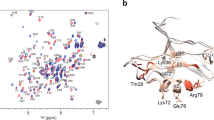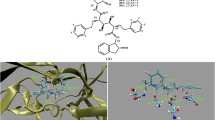Abstract
The protonation state of the Asp dyad is important as it can reveal enzymatic mechanisms, and the information this provides can be used in the development of drugs for proteins such as memapsin 2 (BACE-1), HIV-1 protease, and rennin. Conventional molecular dynamics (MD) simulations have been successfully used to determine the preferred protonation state of the Asp dyad. In the present work, we demonstrate that the results obtained from conventional MD simulations can be greatly influenced by the particular force field applied or the values used for control parameters. In principle, free-energy changes between possible protonation states can be used to determine the protonation state. We show that protonation state prediction by the thermodynamic integration (TI) method is insensitive to force field version or to the cutoff for calculating nonbonded interactions (a control parameter). In the present study, the protonation state of the Asp dyad predicted by TI calculations was the same regardless of the force field and cutoff value applied. Contrary to the intuition that conventional MD is more efficient, our results clearly show that the TI method is actually more efficient and more reliable for determining the protonation state of the Asp dyad.

Similar content being viewed by others
References
Hong L, Koelsch G, Lin X, Wu S, Terzyan S, Ghosh AK, Zhang XC, Tang J (2000) Structure of the protease domain of memapsin 2 (β-secretase) complexed with inhibitor. Science 290(5489):150–153
Murray CW, Callaghan O, Chessari G, Cleasby A, Congreve M, Frederickson M, Hartshorn MJ, McMenamin R, Patel S, Wallis N (2007) Application of fragment screening by X-ray crystallography to β-secretase. J Med Chem 50(6):1116–1123
Yu N, Hayik SA, Wang B, Liao N, Reynolds CH, Merz KM (2006) Assigning the protonation states of the key aspartates in β-secretase using QM/MM X-ray structure refinement. J Chem Theory Comput 2(4):1057–1069
Gordon JC, Myers JB, Folta T, Shoja V, Heath LS, Onufriev A (2005) H++: a server for estimating pK as and adding missing hydrogens to macromolecules. Nucleic Acids Res 33(suppl 2):W368–W371
Rajamani R, Reynolds CH (2004) Modeling the protonation states of the catalytic aspartates in β-secretase. J Med Chem 47(21):5159–5166
Beveridge A, Heywood G (1993) A quantum mechanical study of the active site of aspartic proteinases. Biochemistry 32(13):3325–3333
Friedman R, Caflisch A (2007) The protonation state of the catalytic aspartates in plasmepsin II. FEBS Lett 581(21):4120–4124
Adachi M, Ohhara T, Kurihara K, Tamada T, Honjo E, Okazaki N, Arai S, Shoyama Y, Kimura K, Matsumura H (2009) Structure of HIV-1 protease in complex with potent inhibitor KNI-272 determined by high-resolution X-ray and neutron crystallography. Proc Natl Acad Sci USA 106(12):4641–4646
Chen J, Yang M, Hu G, Shi S, Yi C, Zhang Q (2009) Insights into the functional role of protonation states in the HIV-1 protease–BEA369 complex: molecular dynamics simulations and free energy calculations. J Mol Model 15(10):1245–1252
Coates L, Tuan H-F, Tomanicek S, Kovalevsky A, Mustyakimov M, Erskine P, Cooper J (2008) The catalytic mechanism of an aspartic proteinase explored with neutron and X-ray diffraction. J Am Chem Soc 130(23):7235–7237. doi:10.1021/ja801269x
Ellis CR, Shen J (2015) pH-dependent population shift regulates BACE1 activity and inhibition. J Am Chem Soc 137(30):9543–9546
Park H, Lee S (2003) Determination of the active site protonation state of β-secretase from molecular dynamics simulation and docking experiment: implications for structure-based inhibitor design. J Am Chem Soc 125(52):16416–16422
Shimizu H, Tosaki A, Kaneko K, Hisano T, Sakurai T, Nukina N (2008) Crystal structure of an active form of BACE1, an enzyme responsible for amyloid β protein production. Mol Cell Biol 28(11):3663–3671. doi:10.1128/MCB.02185-07
Mitchell MJ, McCammon JA (1991) Free energy difference calculations by thermodynamic integration: difficulties in obtaining a precise value. J Comput Chem 12(2):271–275. doi:10.1002/jcc.540120218
Frisch MJ, Trucks GW, Schlegel HB et al (2009) Gaussian 09, revision D 01. Gaussian, Inc., Wallingford
Bayly CI, Cieplak P, Cornell W, Kollman PA (1993) A well-behaved electrostatic potential based method using charge restraints for deriving atomic charges: the RESP model. J Phys Chem 97(40):10269–10280
Case DA, Darden TA, III TEC, Simmerling CL, Wang J, Duke RE, Luo R, Walker RC, Zhang W, Merz KM, Roberts B, Wang B, Hayik S, Roitberg A, Seabra G, Kolossváry I, Wong KF, Paesani F, Vanicek J, Wu X, Brozell SR, Steinbrecher T, Gohlke H, Cai Q, Ye X, Wang J, Hsieh M-J, Cui G, Roe DR, Mathews DH, Seetin MG, Sagui C, Babin V, Luchko T, Gusarov S, Kovalenko A, Kollman PA (2011) Amber Tools 15. University of California, San Francisco
Case DA, Darden TA, III TEC, Simmerling CL, Wang J, Duke RE, Luo R, Walker RC, Zhang W, Merz KM, Roberts B, Wang B, Hayik S, Roitberg A, Seabra G, Kolossváry I, Wong KF, Paesani F, Vanicek J, Wu X, Brozell SR, Steinbrecher T, Gohlke H, Cai Q, Ye X, Wang J, Hsieh M-J, Cui G, Roe DR, Mathews DH, Seetin MG, Sagui C, Babin V, Luchko T, Gusarov S, Kovalenko A, Kollman PA (2010) AMBER 11. University of California, San Francisco
Simonson T, Carlsson J, Case DA (2004) Proton binding to proteins: pK a calculations with explicit and implicit solvent models. J Am Chem Soc 126(13):4167–4180
Jorge M, Garrido NM, Queimada AJ, Economou IG, Macedo EA (2010) Effect of the integration method on the accuracy and computational efficiency of free energy calculations using thermodynamic integration. J Chem Theory Comput 6(4):1018–1027
Jorge M, Garrido NM, Queimada AJ, Economou IG, Macedo EA (2010) Effect of the integration method on the accuracy and computational efficiency of free energy calculations using thermodynamic integration. J Chem Theory Comput 6(4):1018–1027. doi:10.1021/ct900661c
Polgár T, Keserü GM (2005) Virtual screening for β-secretase (BACE1) inhibitors reveals the importance of protonation states at Asp32 and Asp228. J Med Chem 48(11):3749–3755
Acknowledgments
This work was financially supported in part by the National Natural Science Foundation of China (grants 21102050), the Natural Science Foundation of Hubei Province of China (grants 2011CDB374, 2015CFB587), and the Fundamental Research Funds for the Central Universities (2011QN245, 2013ZZGH026, 2015QN160).
Author information
Authors and Affiliations
Corresponding author
Rights and permissions
About this article
Cite this article
Huang, J., Zhu, Y., Sun, B. et al. Determination of the protonation state of the Asp dyad: conventional molecular dynamics versus thermodynamic integration. J Mol Model 22, 58 (2016). https://doi.org/10.1007/s00894-016-2926-z
Received:
Accepted:
Published:
DOI: https://doi.org/10.1007/s00894-016-2926-z




